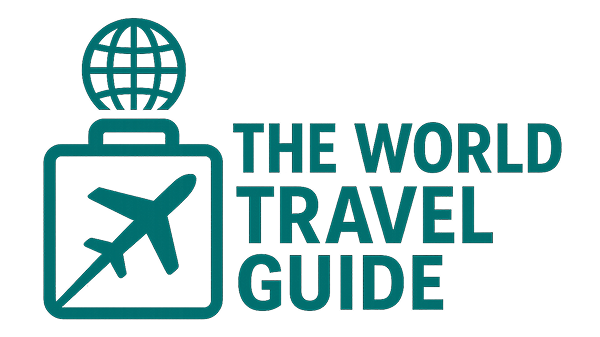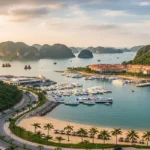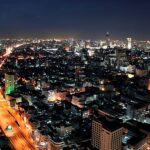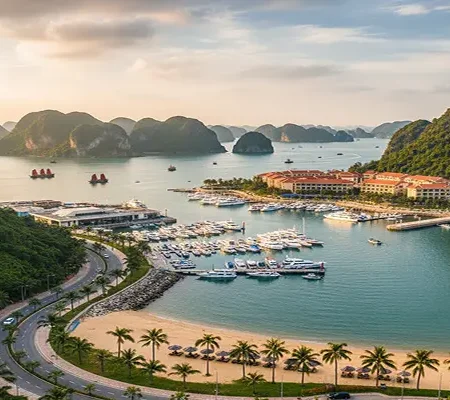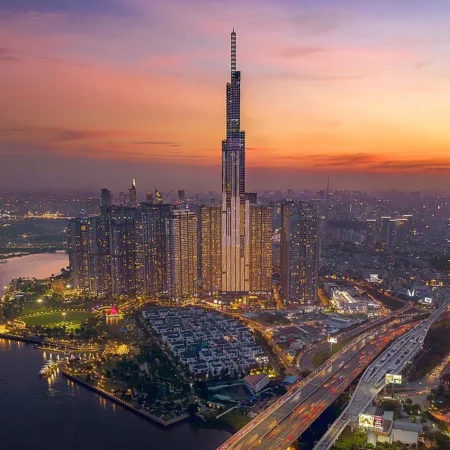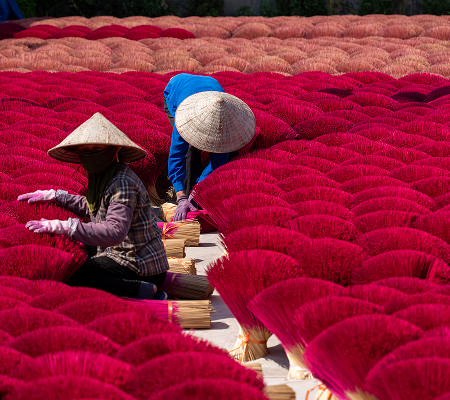Welcome To
Vietnam Trvel
Guide
A Journey Through Vietnam’s Landscapes, Culture & Hidden Gems
Vietnam Travel Guide
Vietnam is a land of captivating contrasts, where ancient traditions blend seamlessly with modern vibrancy. From the bustling streets of Hanoi’s Old Quarter to the serene waters of Ha Long Bay, this Southeast Asian gem offers travelers an unforgettable journey through its rich history, diverse landscapes, and warm hospitality. Whether you’re drawn to the vibrant street food scene, the lush rice terraces of Sapa, or the sun-kissed beaches of Phu Quoc, Vietnam promises a sensory adventure that lingers long after you leave. This comprehensive travel guide dives into everything you need to plan your trip, covering an overview of Vietnam’s allure, quick facts for easy reference, and detailed insights into flights, safety, climate, and budgeting to ensure a smooth and enriching experience.
Overview
Vietnam is a country that captures the heart with its kaleidoscope of experiences. Spanning over 3,260 kilometers of coastline and encompassing rugged mountains, sprawling deltas, and vibrant cities, it’s a destination that appeals to adventurers, culture enthusiasts, and relaxation seekers alike. The capital, Hanoi, buzzes with a chaotic charm, where motorbikes weave through narrow streets lined with colonial architecture and street vendors serving steaming bowls of phở. Ho Chi Minh City, the economic powerhouse in the south, pulses with energy, offering a mix of French colonial landmarks and modern skyscrapers. Beyond the cities, Vietnam’s natural beauty shines—think of the emerald waters and limestone karsts of Ha Long Bay, a UNESCO World Heritage Site, or the terraced fields of Sapa, where ethnic minority communities maintain centuries-old traditions.
The country’s history is as compelling as its landscapes. From ancient dynasties to French colonial rule and the Vietnam War, Vietnam’s past has shaped its resilient and welcoming culture. Travelers can explore historical sites like the Imperial Citadel of Thang Long or the Cu Chi Tunnels, which offer a glimpse into the nation’s wartime history. Vietnamese cuisine, renowned for its fresh ingredients and bold flavors, is another highlight—whether it’s a crispy bánh mì sandwich or a fragrant bowl of noodle soup. With its affordability, diverse attractions, and friendly locals, Vietnam is a destination that invites exploration and leaves a lasting impression.
Quick Facts
Vietnam’s key details make trip planning straightforward. Here’s a snapshot of essential information to get you started:
Language
Vietnamese is the official language, a tonal and monosyllabic language with a rich vocabulary. While English is increasingly spoken in urban centers like Hanoi, Ho Chi Minh City, and Da Nang, rural areas may present language barriers. Learning basic phrases like “Xin chào” (hello) or “Cảm ơn” (thank you) can enhance your experience. Translation apps like Google Translate are highly recommended.
Transport Apps
Grab is the leading ride-hailing app for taxis and motorbikes. Google Maps and XE Currency Converter are also invaluable for navigation and budgeting. Download offline data for reliability in areas with spotty internet.
Region
Vietnam is in Southeast Asia, bordered by China to the north, Laos and Cambodia to the west, and the South China Sea to the east. It’s divided into eight regions, each with distinct cultural and geographic characteristics, from the mountainous Northwest to the Mekong River Delta in the south.
Capital
Hanoi, a city steeped in history, serves as Vietnam’s cultural and political hub. Its Old Quarter is a must-visit for its vibrant street life and historical sites like Hoan Kiem Lake.
Visa
Most travelers require a visa to enter Vietnam. An e-visa, valid for up to 90 days, is available online for many nationalities, taking 3–4 days to process at a cost of about 25 USD. Some countries, including the UK, enjoy visa-free entry for up to 45 days. Always ensure your passport is valid for six months beyond your departure date.
Climate
Vietnam’s climate varies by region. The north has four seasons, with cooler winters (November–April), while the south is tropical, with a dry season (November–April) and a rainy season (May–October). Central Vietnam sees heavy rains and typhoons from September to November.
Power Plugs
Vietnam uses Type A, B, and C plugs at 220V, 50Hz. A universal travel adapter is recommended for compatibility.
Currency
The Vietnamese Dong (VND) is the official currency. With an exchange rate of approximately 1 USD to 25,000 VND, it’s wise to carry cash for small transactions, especially in rural areas. ATMs are widely available in cities, and credit cards are accepted in major establishments.
Flights
Getting to Vietnam is easier than ever, with its three major international airports: Noi Bai in Hanoi, Tan Son Nhat in Ho Chi Minh City, and Da Nang in Da Nang. These hubs connect Vietnam to global cities like Tokyo, Seoul, Bangkok, and Singapore, with additional international airports in Phu Quoc, Can Tho, and Cam Ranh serving select routes. For travelers from the UK, expect a flight time of around 15 hours, often with a layover in a major Asian hub. From the US, flights typically connect through cities like Tokyo or Seoul, with total travel times ranging from 17 to 22 hours depending on the departure city. Budget airlines like Vietjet Air and Bamboo Airways offer affordable domestic and regional flights, while Vietnam Airlines, a 4-star carrier, provides premium service.
To find the best deals, use flight comparison platforms like Skyscanner, which searches budget airlines and smaller websites for competitive fares. Booking on weekdays or during off-peak seasons (March–May or September–October) can save you money. Domestic flights within Vietnam are a time-efficient way to cover the country’s length, with one-way tickets starting at around 590,000 VND (approximately 24 USD). For example, a flight from Hanoi to Ho Chi Minh City takes two hours, compared to a 30-hour train journey. Always check visa requirements before booking, as you’ll need a valid visa or visa exemption to board international flights. Confirm your flight includes check-in procedures for connecting domestic flights, as you may need to clear immigration in Hanoi or Ho Chi Minh City even for onward travel.
Safety
Vietnam is generally a safe destination for travelers, boasting a low violent crime rate of 1.5 per 100,000 inhabitants, significantly below the global average. Locals are known for their friendliness and hospitality, making it a welcoming place for visitors. However, like any travel destination, there are precautions to take. Petty crimes such as pickpocketing and bag-snatching are common in crowded tourist areas, especially in Ho Chi Minh City and Hanoi. To stay safe, keep valuables in a hotel safe, carry bags on the opposite side of traffic, and avoid flashy displays of wealth. Motorbike theft, where thieves on bikes grab bags, is a noted risk, so hold bags securely in front of you.
Road safety is a significant concern due to chaotic traffic, particularly in urban centers. Traffic accidents are a leading cause of injury, with motorbikes dominating the roads. If renting a motorbike, always wear a helmet (mandatory by law) and ensure you have a valid Vietnamese driver’s license for vehicles over 50cc. Exercise caution when crossing streets, as drivers may not follow traffic rules consistently. Natural risks include dengue fever and malaria in rural areas, especially during the rainy season (May–October). Use mosquito repellent and wear long sleeves in rural or farmland areas. During the monsoon season (June–October), flooding and typhoons can disrupt travel, particularly in the Mekong Delta and Central Vietnam. Stay updated with local weather advisories and follow authorities’ guidance.
For solo travelers, especially women, Vietnam is considered relatively safe, but standard precautions apply. Dress modestly, particularly at religious sites, and avoid walking alone late at night in unfamiliar areas. Respect local customs, such as removing shoes at temples and asking permission before photographing people, especially ethnic minorities. Carry a photocopy of your passport and visa, as authorities may request ID. In case of emergencies, contact your embassy or consulate, and ensure you have comprehensive travel insurance to cover medical or legal issues.
Climate
Vietnam’s climate is as diverse as its geography, shaped by its long coastline and varied terrain. The country is divided into two main climatic zones. Northern Vietnam, including Hanoi and Sapa, experiences a tropical monsoon climate with four distinct seasons: spring (March–May), summer (June–August), autumn (September–November), and winter (December–February). Winters in the north can be cool, especially in mountainous areas like Sapa, where temperatures may drop to 5°C (41°F). The south, including Ho Chi Minh City and the Mekong Delta, has a tropical climate with two seasons: dry (November–April) and rainy (May–October). Southern temperatures remain warm year-round, averaging 25–35°C (77–95°F), with high humidity.
Central Vietnam, including Hue and Da Nang, faces intense weather, with heavy rains and typhoons from September to November. The best time to visit Vietnam overall is from December to April, when the weather is cooler and drier, though this is also peak tourist season. For northern destinations, spring (March–May) and autumn (September–October) offer pleasant temperatures and lower rainfall. In the south, the dry season (November–January) is ideal for beach destinations like Phu Quoc or Nha Trang. Be prepared for sudden downpours during the rainy season, and pack lightweight, breathable clothing with a rain jacket or umbrella. Climate change has increased the severity of typhoons, particularly along the coast, so monitor weather updates, especially in central regions during late summer and autumn.
Budget
Vietnam is one of Southeast Asia’s most budget-friendly destinations, offering excellent value for travelers of all styles. A budget traveler can expect to spend $150–$300 per week, covering hostels (120,000–360,000 VND or $5–15 USD per night), street food (20,000–50,000 VND per meal), and public transport like buses or trains. Mid-range travelers might spend $300–$700 per week, enjoying private hotel rooms ($30–70 USD per night), local restaurants, and occasional domestic flights. Luxury travelers can indulge in upscale hotels, fine dining, and private tours for $700 or more per week. A couple’s week-long trip, including accommodation, meals, transport, and attractions, averages around 24.4 million VND ($962 USD).
To save money, eat at local eateries where dishes like phở or bánh mì cost as little as 20,000 VND ($0.80 USD). Public buses are an economical way to travel between cities, with fares as low as 100,000 VND ($4 USD) for long-distance routes. For faster travel, domestic flights start at 590,000 VND ($24 USD). Haggling is common in markets, but do so politely. There’s no tipping culture, though small tips for exceptional service are appreciated. Carry cash, as many small vendors don’t accept cards, and exchange money at banks or authorized outlets to avoid scams. Budget accommodations in tourist areas like Hanoi’s Old Quarter or Ho Chi Minh City’s District 1 offer convenience without breaking the bank. For a richer experience, book tours with reputable local operators who can tailor itineraries to your interests, saving time and enhancing your trip.
By planning ahead, using apps like Grab for transport, and embracing Vietnam’s affordable offerings, you can craft a memorable trip that suits your budget and leaves room for spontaneity. Whether you’re savoring street food or exploring ancient temples, Vietnam’s charm is accessible to all.

